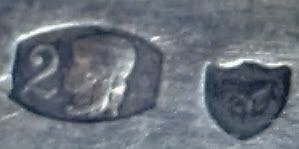Hi,
Hold your horses, I think it is too early to draw any conclusions from these two examples of spoons marked A Riedel and Josef (Osipov) Sosnkowski - assay mark 1880.
According to Whetstone William B., Niklewicz Danusia V., Matula Lindy L. (2009), World Hallmarks, Volume I, Europe, 19th to 21st Centuries, the owl mark was placed on used precious metal articles that did not have a manufacturer or maker’s marks.
"The first owl approval mark, used from 1920 to 1963, was placed on used precious metal articles that did not have a manufacturer or maker’s marks.. ..These marks have often been referred to as lombard marks, after the Polish word lombard for pawn or used items."
From the Poland Chapter in - World Hallmarks, Vol.I, Europe
According to Gradowski, Michal (1994), Znaki na Srebrze:...: Marks on Silver in Poland; "Cecha zwana lombardowa — tarcza z glowa sowy — bita obok normalnych cech probierczych nie opatrzonych zarejestrowana w urzedzie cecha imienna (najczesciej byly to wyroby dawne, sprzedawane na licytacji przez lombardy)." (ibid p. 266)

According to the Hallmarking Law of 1931 (ROZPORZÄ„DZENIE MINISTRA PRZEMYSÅU I HANDLU, Department of Industry and Trade) (In .pdf search google.com---tarcza z glowa sowy- probably the first hit)

A probably not good enough translation...
...The mark was punched on items that
1. according to state regulations do not have
registered manufacturers' or hallmarks, and submitted to the pawnshops.
2. are of older origin and according to state regulations do not have
registered manufacturers' and hallmarks and are put up for sale. (perhaps second hand dealers, auction houses)
3.
Here I am totally lost in translation! I think that I have understood that this is about exemptions from marking.
In practice I think that the assay offices worked as follows:
a) A piece marked 11 lot- the assay office punched it with the lombard mark without the official hallmark (the woman with the number 1-3, according to silver standard). Silver- but not one of the Republic of Poland's registered standards; 940, 875, 800
b) A piece marked 800 of German or Austro-Hungarian origin, perhaps made in Breslau or Cracow (crescent and crown or head of Diana), the assay office punched it with the lombard mark together with the official hallmark (the woman with the number 3).
c) A piece marked 84 according to Russian hallmarking laws (as the example above), the assay office punched it with the lombard mark together with the official hallmark (the woman with the number 2).
It actually hit me that the rules seem to correspond to the French swan-mark (Cygne).
This is my theory, but I am lost in translation, so I would be very grateful if someone helps me with it. Perhaps will you,
dnl, or someone else provide us with the omitted parts of the quotation from World Hallmarks above.
I hope that we, once and for all, together will find the truth about the lombard mark (cecha Lombardowa or cecha pomocnicza).
Please provide us with examples!
Best regards/JAKJO
.









